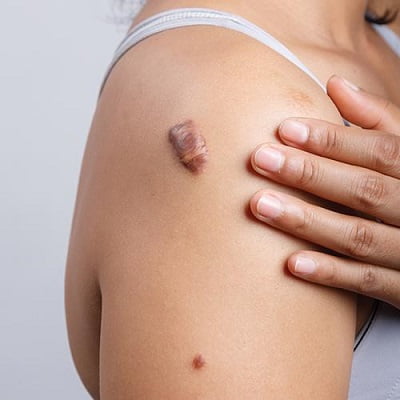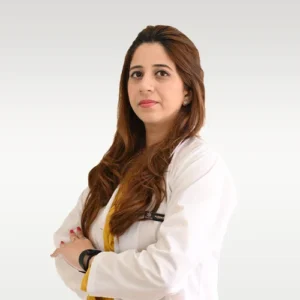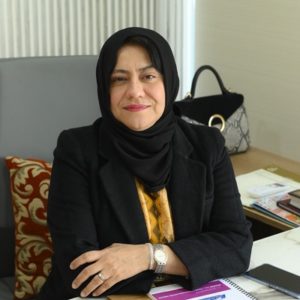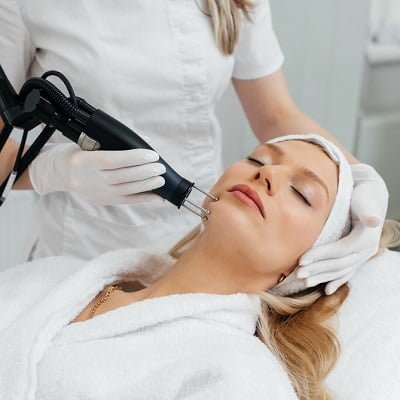
A keloid scar is a raised scar. It develops months to a year after the injury that caused it. The scar becomes larger than the original wound. Keloids do not fade with time. A dermatologist may recommend treatments such as corticosteroid injections or pressure garments to help decrease its size and look. Keloids therapy, also known as keloid scar treatment, is the treatment of thick, jumbled, and irregularly formed scars that rise abruptly above the skin. Keloids are sometimes defined as pink or purple scars that spread uncontrollably. Keloids grow gradually and, unlike scars, do not fade over time.
Quick Facts
- Procedure Type: Non-Surgical/ Surgical
- Duration: 20-60 Minutes
- Recovery: Immediately
- Results: Long-Lasting
- Cost: PKR 2,999
What Are Keloid Scars?
A keloid scar (keloid) is a raised scar that expands beyond the lesion that created it. These scars often grow slowly, taking months to years to form following a skin injury. These scars do not fade. They may have an impact on your self-esteem and how you perceive your physical appearance. A healthcare physician might recommend therapies to help decrease the look of scars on your skin.
Types Of Keloid Scars
There are several types of scars. Some scars are minor and fade away when the wound heals. Other scars are slightly bigger than the “original wound” and are referred to as “Hyper-Trophic” (meaning greater) scars, while “Keloids” refer to scars that continue to grow larger than the initial injury or wound site. “Keloids” commonly begin with a skin damage site or a little scar from a pimple (acne) on the chest or back, but can occur anywhere on the body. To understand more about keloids, go here.
How Do Keloid Acne Scars Appear?
Keloid acne scars have been shown to form and proliferate following surgery or damage, eventually extending beyond the wounded skin. Keloids may also form on the skin unexpectedly or as a result of edema. Ear piercings and burns are also known to cause keloids.
Where Do Keloid Scars Grow?
A keloid scar can form anywhere on the skin. The most frequent sites might include your:
- Abdomen.
- Back.
- Chest.
- Ear.
- Jaw.
- Shoulder.
What Are The Symptoms Of A Keloid Scar?
The signs of a keloid scar are:
- A raised scar larger than the incision that generated it.
- Itchy skin.
- Pain and soreness, as well as a burning feeling or discomfort, can occur as the scar expands.
- In certain situations, the scar may get large enough to alter the function or limit the range of motion of that part of your body.
Types Of Keloid Treatments
Following are the types of Keloid Treatments that can remove scars from your body;
Keloid Treatments | Description |
| Wound Care | For newer keloids, the first treatment option may be compression dressings consisting of elastic cloth or other materials. This procedure can also be used to eliminate keloids following surgery. The idea is to decrease or avoid scars by applying pressure to the incision while it heals. These dressings must be used for 12 to 24 hours every day for 4 to 6 months to be effective. This procedure can be quite unpleasant. |
| Corticosteroid Cream | Applying a prescription-strength corticosteroid lotion can help relieve itching. |
| Injected Medicine | If you have a smaller keloid, your doctor may try to reduce its thickness by injecting cortisone or other hormones. You will most likely require monthly injections for up to six months until the scar flattens. Corticosteroid injections may cause skin thinning, spider veins, and a permanent change in skin color (hypopigmentation or hyperpigmentation). |
| Freezing The Scar | Small keloids can be decreased or eliminated by freezing them in liquid nitrogen (cryotherapy). Repeat treatments may be necessary. Cryotherapy can cause burning, discomfort, and loss of skin color (hypopigmentation). |
| Laser Treatment | Larger keloids can be flattened using pulsed dye laser treatments. This approach has also been shown to reduce itching and diminish keloids. Pulsed-dye laser treatment is administered in numerous sessions spaced 4 to 8 weeks apart. Your doctor may consider combining laser treatment and cortisone injections. Side effects that are more likely in those with darker skin include hypopigmentation or hyperpigmentation, blistering, and crusting. |
| Radiation Therapy | Low-level X-ray radiation, used alone or after surgical excision of a keloid, can help shrink or reduce scar tissue. Repeat treatments may be necessary. Radiation therapy can cause skin issues and, in the long run, cancer. |
| Surgical Removal | If your keloid has not responded to prior therapy, your doctor may prescribe surgery in conjunction with other treatments. Surgery alone has a recurrence rate ranging from 45% to 100%. |
How Does Keloid Treatment For Scar Removal Work?
A great deal of investigation goes into steering a patient to a certain treatment. Following these stages, the doctor begins a specific procedure. There are surgical and non-surgical procedures for removing the keloid. However, in comparison to contemporary non-invasive approaches, these surgical procedures are insignificant since keloids can regenerate as a result of collagen formation. The therapies offered at our clinic are as follows:
What To Expect In Results?
The therapy outcomes are always determined by the patient’s desires. Your skin will be scar-free, and there will be no soreness or hurting following the procedure. You may require more than one session depending on your condition. To undertake the operation, you need to consult a specialist.
Benefits:
Keloid Treatment can offer top benefits, including:
- The skin tone will improve.
- Most therapies are effective, with around 95% of people.
- This is an excellent method.
- Your skin will be clean of scars and keloids.
- Quality of life will improve.
- You can walk with elevated shoulders.
Who Is An Ideal Candidate For Keloid Treatment?
Anyone can be an ideal candidate for Keloid Treatment if they;
- Have a visible keloid that is causing discomfort or distress.
- Are in good general health
- Have realistic expectations about the outcomes.
- Are committed to following post-treatment instructions
When To See A Doctor For Keloid Scar?
If you have keloids, you should schedule an appointment with your dermatologist right away so that they can devise a treatment plan for you.
How Long Does Keloid Treatment Results Last?
Keloid treatment outcomes might vary, and while some keloids may decrease, they are prone to recurrence. While various therapies, such as steroid injections and cryotherapy, can greatly reduce the look and size of keloids, many will come back within 5 years. Keloids are seldom completely eradicated, thus, a combination of therapies may be employed to reduce recurrence and enhance outcomes.
Initial Consultation
Call your doctor if you see a change in your skin that indicates a keloid is growing, or if you have had a keloid for a time and want to get it treated. Your doctor can typically identify if you have a keloid by inspecting the afflicted skin. You may require a skin biopsy to rule out skin cancer. Following your initial session, your doctor may send you to a dermatologist (a specialist who specializes in the diagnosis and treatment of skin disorders).
How Do Doctors Diagnose A Keloid Scar?
A keloid scar is diagnosed by a healthcare expert following a physical examination. Testing is frequently unnecessary because the look of the scar provides an accurate diagnosis. If your doctor suspects another ailment or wants to rule it out, they may do a skin biopsy to study a small portion of your damaged skin tissue under a microscope.
How To Prepare For Keloid Treatment?
You can prepare for Keloid Treatment by following these instructions;
- Avoid tanning and sun exposure in the keloid region.
- Disclose any drugs you are currently taking.
- Avoid using harsh skincare products on the scar prior to treatment.
- Stay hydrated and follow a healthy diet.
What To Expect During Keloid Treatment For Scar Removal?
Following are the stages involved in Keloid Treatment:
- Medications (corticosteroid injections or creams ( 5-fluorouracil injections).
- Laser skin resurfacing (light beams targeted on the scar).
Other therapies might include:
- Cryotherapy (frozen scar).
- Pressure garments are tight clothing that puts pressure on a specific part of your body.
- Ligature (tying a surgical thread around the keloid to help it come off naturally).
- A physician will select the appropriate treatment option depending on the size, shape, and depth of the scar in your skin. Your overall health and age might also be important considerations. Keloids are often treated using many methods.
Keloid Treatment Aftercare Instructions
Following aftercare instructions are critical for achieving optimal results and reducing problems.
- Wound care is time-consuming, and compression dressings may be painful. Try to keep to the schedule prescribed by your doctor, since these actions are critical for keloid prevention.
- Apply corticosteroid cream. This sort of nonprescription ointment can assist with irritation.
- Applying nonprescription silicone gel can help relieve itching.
- Avoid rubbing or injuring the keloid.
- Sun exposure may alter the color of your keloid, making it more visible. That alteration can be irreversible. Before going outside, cover the keloid or heavily apply sunscreen.
How Can I Prevent Keloid Scars?
You cannot avoid keloid scars. If you know you are more likely to acquire one, you can lower your risk by:
- Protecting your skin from harm and using safety equipment as needed.
- Not getting any piercings or tattoos.
- Applying a silicone gel patch or wound dressing to your skin after an injury.
- When going outside, wear insect spray.
- Your physician can offer you with more information regarding preventative techniques based on your specific situation.
Keloid Scar Treatment Side Effects
Following are Keloid Treatment side effects;
- Temporary redness
- Swelling and mild bruising
- Temporary skin discoloration
- Scabbing or dryness as the skin heals
Cost of Keloid Treatment In Islamabad
The cost of Keloid Treatment in Islamabad, Pakistan, may range from PKR 2,999. On average, the cost of Keloid Treatment in Pakistan is determined by numerous factors, including the treatment area, number of sessions, and the dermatologist’s fees. The consultation fees of keloid treatment range from PKR 2,999 to PKR 5000.
Cost-related factors:
- Experience of the physicians
- Location of the clinic
- Standard of the clinic
- The type of therapy that is in progress
- Determine the number of keloids on the skin and the number of sessions necessary.
Starting Cost (PKR) PKR 2,999 |
Why Choose SKN Cosmetics For Keloid Scar Treatment In Islamabad!
Other keloid scar removal methods can also be employed. If you have keloids, schedule a dermatological appointment with Dr. Mariam Malik, who has successfully treated hundreds of keloid acne scar patients. SKN Cosmetics, a skincare clinic in Islamabad, is equipped with cutting-edge technology to assist in analyzing your keloid condition and provide a treatment plan that is right for you. Dr. Mariam Malik is a board-certified aesthetic physician with extensive experience in skin treatments.
Book Your Free Consultation!
Therefore, if you search for an effective and permanent solution for removing keloids, feel free to consult SKN cosmetics for treatment. We are offering several options of procedures and will provide satisfying services and excellent results. We are looking forward to seeing you!
FAQs










Book your Appointment